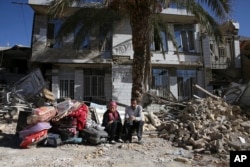Many survivors in Iran were still awaiting badly needed aid on Wednesday, three days after the powerful earthquake along the Iraq border killed more than 530 people and left thousands injured.
The delay in getting help to the needy came as public order broke down in many instances where aid was being delivered. Officials said families that were not affected by the quake rushed and took some of the aid supplies.
The police said they deployed forces to secure aid distribution and prevent more chaotic outbreaks.
Many in the Kurdish town of Sarpol-e Zahab, home to half the casualties from the temblor, told The Associated Press that they still have not received aid and that they needed help to remove debris so they could try to get to their damaged homes and retrieve some essential belongings.
Reports said more than 12,000 tents were distributed in the area, though more than 30,000 houses were affected by the quake — 15,500 of them completely destroyed. Debris removal was expected to end within the next 10 days.
Iran's Supreme Leader Ayatollah Ali Khamenei urged late on Tuesday for continued aid shipments to the area ahead of the "cold weather and difficult cold season."
Iranian officials blamed the slow aid in part on the chaotic situation in the stricken region. Interior Minister Abdolreza Rahmani Fazli told an open session of the parliament on Thursday that a total of 36,000 tents had been sent to the region, including those already distributed.
Many families unaffected by the earthquake had rushed to aid distribution places and taken supplies that were not meant for them, Fazli added.
Because of a lack of public order, some dispatches of aid deliveries were "blocked" before reaching their destination, he also said.
Morteza Salimi of the Iranian Red Crescent told state TV that despite enough aid supplies, "there were some problems in distributing the relief ... safety and security were violated."
Iran's deputy police chief, Gen. Eskandar Momeni, visited the area and told reporters that his forces would ensure "security for the distribution of assistance."
The region, reconstructed in the decades since Iran's 1980s war with Iraq, was hit by a magnitude 7.3 earthquake on Sunday night. The official IRNA news agency said 530 were killed while state TV put the number at 432. There was no explanation for the discrepancy though double-counting and burying bodies in remote villages without informing officials are common occurrences in the country.
The quake injured 9,388 people, according to a Wednesday report by the semi-official ISNA news agency. Of those, some 1,400 were still hospitalized.
The temblor hit about 19 miles (31 kilometers) outside the eastern Iraqi city of Halabja, according to the U.S. Geological Survey, and struck 14.4 miles (23.2 kilometers) below the surface, a somewhat shallow depth that can cause broader damage.
Nine people were killed in Iraq and 550 were injured, all in the country's northern, semiautonomous Kurdish region, according to the United Nations.
Iran sits on many major fault lines and is prone to near-daily quakes. In 2003, a magnitude 6.6 earthquake flattened the historic city of Bam, killing 26,000 people. In 2012, a major casualty earthquake killed over 300 in northeast of the country.












